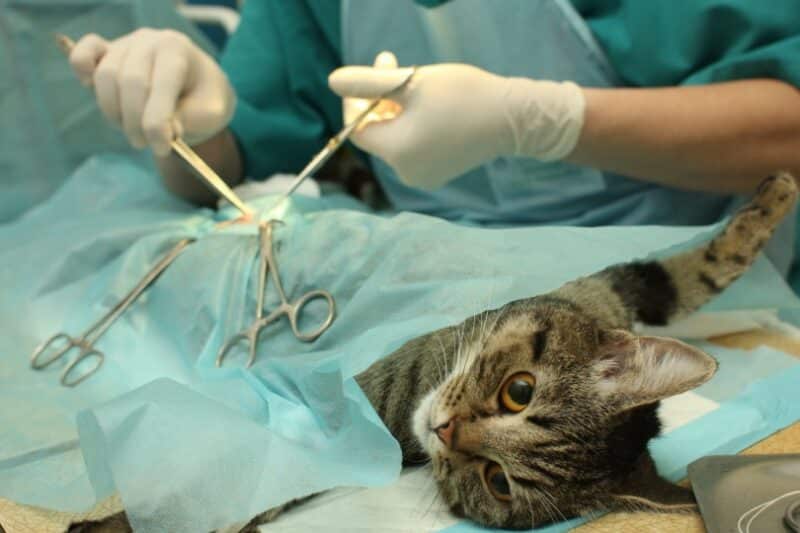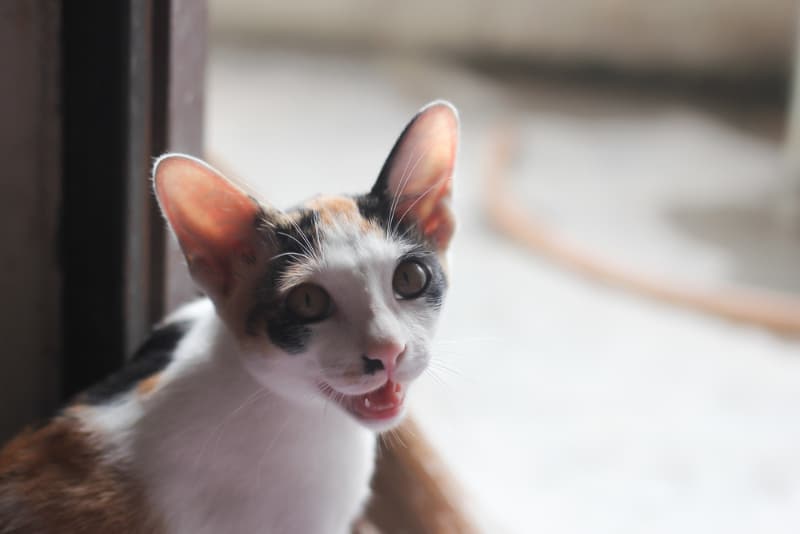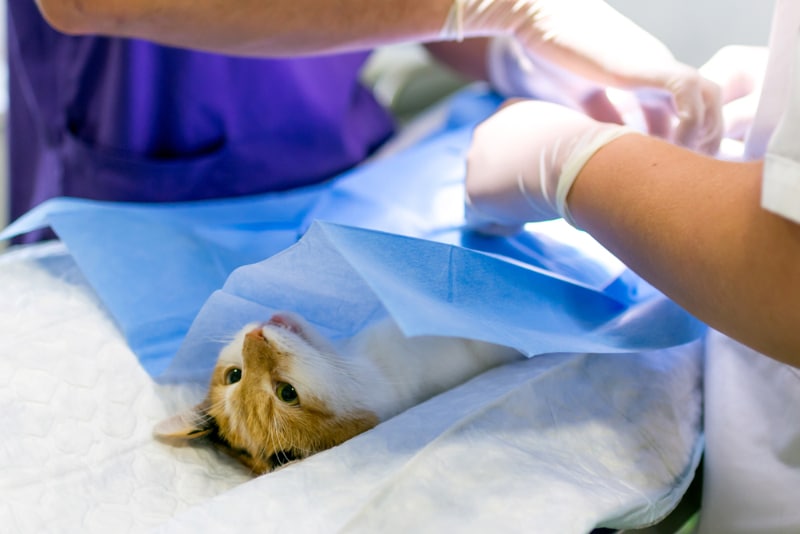You adopted your cat from a shelter, and she or he was already spayed. Now, several years later, she yowls and acts like she could possibly be in heat, but that couldn’t be possible, right?
You bring it as much as your vet during your cat’s semi-annual physical exam, and so they suggest that your cat could have ovarian remnant syndrome. Let’s dive into what that would mean and what to do on your cat.
Click Below to Jump Ahead:
What Is Ovarian Remnant Syndrome?
Ovarian remnant syndrome is a condition where there continues to be some ovarian tissue left within the abdomen after a vet has spayed your cat. This condition may occur in dogs.
You would possibly notice that your cat is showing signs consistent with being in heat or estrus. While they will’t get pregnant, affected cats could also be drawn to males. Your veterinarian will examine your cat and suggest specific tests to verify a diagnosis of a retained ovarian remnant.
Typically, this condition occurs because a chunk or a whole ovary is left inside your cat’s abdomen in the course of the spay procedure. Some cats can have ectopic ovarian tissue, which is ovarian tissue in an abnormal place throughout the body.
Image Credit: Chan Deshpong, Shutterstock
What Are the Signs of Ovarian Remnant Syndrome in Cats?
Because cats with retained ovarian tissue experience hormone cycles, they may show signs just like an unspayed female. Interestingly, it may possibly take years for a cat to indicate signs of a retained ovarian remnant. In response to the Animal Surgical Center of Michigan, affected cats will show signs of a heat cycle a mean of 15.5 months after spaying. As well as, roughly 17% of spay complications involve ovarian remnants.
Common signs of a retained ovary are bloody discharge out of your cat’s vulva and an enlarged or swollen vulva. Because cats are avid groomers, chances are you’ll not see either of those signs in your cat.
One other sign of estrus in cats is increased vocalization. Your ordinarily quiet cat may yowl constantly. They may also be increasingly restless. If you will have an intact, unneutered male cat, your female may allow or encourage copulation, but they may not give you the chance to get pregnant.
Secondary to hormone changes, your cat’s mammary glands and nipples may enlarge.
What Are the Causes of Ovarian Remnant Syndrome in Cats?
Essentially the most common reason for ovarian remnant syndrome in pets is surgical error. The surgeon leaves a portion of the ovary remaining after surgical removal of the ovaries during a spay. This complication could also be a bit more common in cats than dogs because it may possibly be harder to visualise the entire ovary because it’s harder to interrupt down the right ligament in cats than in dogs.
One other potential cause is ectopic ovarian tissue. This cause pertains to ovarian tissue not being positioned in a traditional position in your cat’s abdomen. As an alternative of its usual location throughout the ovary, some ectopic tissue could be present in places just like the broad ligament. In case your veterinarian doesn’t detect this ectopic tissue during surgery, it gets left behind and becomes an ovarian remnant.
The remaining tissue becomes hypertrophied after some time and continues to secrete reproductive hormones, resulting in signs of estrus.
You do have to be careful about certain medications because they may mimic your cat having an ovarian remnant. In the event you use a topical estrogen cream and your cat can touch or lick it off, they will present like your cat is having a heat cycle.

Diagnosing Ovarian Remnant Syndrome in Cats
Your veterinarian could have a powerful suspicion that your cat has ovarian remnant syndrome, nevertheless it must be confirmed through testing before any intervention.
First, ensure there’s no likelihood that anyone has exposed your cat to topical estrogen or progesterone.
Your veterinarian may perform vaginal cytology to search for cellular changes consistent with a heat cycle, most notably cornified vaginal epithelial cells.
The perfect support for ovarian remnant syndrome is using two hormone tests.
- Progesterone levels must be lower in a spayed female.
- Anti-müllerian hormone levels must be checked. A positive test indicates that ovarian tissue is within the cat, while a negative test means it isn’t.
How Do I Take care of a Cat With Ovarian Remnant Syndrome?
Unfortunately, in case your cat has ovarian remnant syndrome, they’ll need surgery to remove the remaining ovarian tissue. Some veterinarians can perform this surgery laparoscopically, where your vet will make a series of small incisions and use a camera to discover the tissue.
Sometimes, your veterinarian will perform an exploratory surgery to discover the retained tissue. The procedure is completed the identical way as your cat’s initial spay.
After surgery comes the hard part: keeping your cat quiet and calm for about 10 days. If you will have a really energetic kitty, your veterinarian might prescribe sedatives to maintain them calm.
Gabapentin could also be used as a pain medication and a gentle sedative. They’ll also generally receive pain-relieving anti-inflammatory medication, similar to Onsior (robenacoxib).
As hard because it may be, your cat should wear an Elizabethan collar (e-collar, for brief). This normally rigid “cone of shame” will help keep your cat from licking or chewing at their incision, which could cause it to develop into inflamed, infected, and even reopen. Some cats do well with a bodysuit, so check with your vet about what option might work best on your cat.
Image Credit: ARVD73, Shutterstock
Continuously Asked Questions (FAQ)
How common is ovarian remnant syndrome in cats?
Ovarian remnant syndrome just isn’t a typical occurrence after a spay, nevertheless it does look like more common in cats than dogs. Of post-ovariohysterectomy complications, lower than 20% are retained in ovarian tissue.
One study checked out pre-surgical variables to see if anything was common to reviewed cases. The age of the pet and its breed weren’t significant aspects. Interestingly, even obesity didn’t increase the chance of a cat having ovarian tissue left behind.
Can ovarian remnants develop into cancerous?
Ovarian remnants have the potential to develop into cancerous, at the least in humans. We do know that, in pets, retained ovarian tissue could be linked to several cancers developing outside of the ovaries, similar to mammary cancer (similar to mammary gland adenocarcinoma) and vaginal cancer
Your cat can also be at the next risk for developing a uterine stump pyometra, an infection throughout the remaining portion of the uterus.
Conclusion
Ovarian remnant syndrome can occur in cats in consequence of poor surgical technique, trouble exposing the ovaries during an ovariohysterectomy, and even extra ovarian tissue in an abnormal place inside your cat’s body. Your veterinarian will partner with you on surgery or refer you to a facility for laparoscopic surgery.
Featured Image Credit: megaflopp, Shutterstock




